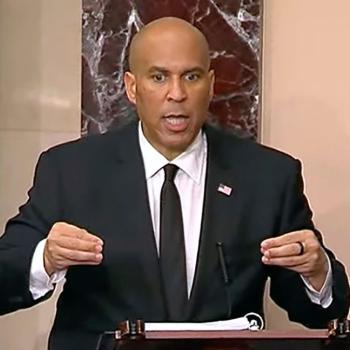Using a ‘dialogical lens’ for scripture and preaching can open new options for “Purple Zone” sermons in the red-blue divide.

Immigration. Healthcare. Money and possessions. Environmental issues. The list of topics of public concern is long and complex. Some say preachers should’t address contemporary issues. But the fact is that Jesus, the prophets, and the Bible itself all have something to say about a myriad of topics that relate to issues we’re facing today. Thus, clergy and the church are authorized to speak to these topics from a biblical perspective.
But how can we preach about these issues in a way that invites dialogue rather than driving a wedge into the red-blue divides of our congregations?
For Christians, all of these contemporary issues must be brought into conversation with our understanding of a God who continues to be active in Creation and human history. That’s exactly why rooting our preaching in the Bible is useful for these “pollinating” conversations. The Bible shows us what it looks like for faithful people to disagree while discerning how to be the people of God.
So we need to spend some time thinking about the ways in which conversations happen in the stories of the Bible, how the books of the Bible are themselves in dialogue, and how the Bible converses with us today.
In other words, we need a dialogical lens for reading scripture.
This lens enables us to see how God works in and through our complicated, messy, conflicted, and yet faithful conversations in order to bring about discernment, justice, healing, and reconciliation. In this post I’ll show you how to employ this dialogical lens. In subsequent posts, we’ll look at how the dialogical lens can be applied to different scriptural texts.
Exegetical Tools for Interpreting Scripture Through a Dialogical Lens[1]
Utilizing the dialogical lens requires us to draw from different exegetical methods. The historical-critical method is useful for determining the author of the work, its original audience, other intertextual sources, and the social, historical, or cultural influences with which the author may be implicitly or explicitly in conversation. Literary analysis will be helpful as we determine the characters and their roles in the story and the rhetorical techniques being used in the text. But the dialogical lens will also require some interpretive imagination, since the text sometimes only hints at the motivations and emotions of the characters and authors.
At the same time, we need to consider the reader-response method because of the way in which the text will be heard and interpreted by readers in our contemporary contexts. Finally, the dialogical lens benefits from feminist interpretation, liberation theology, and John McClure’s “other-wise” homiletic.[2] Each of these enables us to ascertain the voices in the conversation that are not heard or acknowledged, but who nevertheless have a stake in the outcome. With these critical methods in mind, here are six steps for using the dialogical lens.
Six Steps for Using the Dialogical Lens
1. Point out the dialogical aspects of the passage.
In broad terms, describe how this passage of the Bible is an instance of conversation, dialogue, or some other kind of interchange. Who is the (presumed) author, and who was the intended audience? What were the social, cultural, and political forces either in the background or directly present in the passage? What other books or authors in the Bible are implicitly in conversation with this text or author? If the story is a narrative, who are the characters? Who speaks? Who’s in the background? Who is in the scene but silent?
2. Determine what’s at stake.
What is the presenting issue? Can you identify the fears or concerns of the author, the audience, or the characters? What are they afraid of losing? Who or what is threatening to them? What are the overt or underlying tensions or conflicts?
3. Identify the values.
This gets at the deeper ideals and principles that underlie a character’s actions or writer’s intentions. What is important to them, and what do they cherish or hold dear? What is their “best self” that could emerge? Find the overlap – and the gaps. What desires, fears, and values do the characters or figures share? In other words, where are points of commonality among or between them? At the same time, where are there vast differences? What are the things the dialogue partners are unlikely to agree upon?
4. Explain how God, Jesus, and/or the Holy Spirit is active.
What is God doing in the midst of this interchange? Is God’s action explicit, implicit, or apparently absent? How is the larger community wrestling with or expressing their faith in God?
5. Recognize what the dialogue is teaching us.
What is this exchange, dialogue, or conversation teaching us about what it means to be the church and faithful Christians in the midst of contentious public issues? In what way can we learn about being God’s people who engage the conflicts and sin of the world, while maintaining the commitment to grace, hope, and love? What can we determine about who God is, what God does, and what God intends for us based on this interchange and dialogue in the passage?
6. Suggest possible next steps.
What are next steps we might take based on what this biblical passage models for us? Are we sensing God’s invitation to engage public concerns? Are we being invited into dialogue with each other, with this passage, and with God about specific justice issues? Can we learn what not to do based on what we see in this text? Are there common values we share that can be the basis for our response to a societal matter? What kind of church shall we be, knowing what the Bible models for us, and knowing what challenges our community is facing?

To read more about the dialogical lens and how it fits within the “Five Paths of Prophetic Preaching,” check out my book, Preaching in the Purple Zone: Ministry in the Red-Blue Divide.
These steps and the questions therein will come into play when we craft sermons about specific issues we want to address in our sermons, as well as in the deliberative dialogue forums we facilitate in our congregations. Preaching using a dialogical lens shows listeners that the church is permitted, authorized, encouraged, and even urged to preach about public issues precisely because Scripture has already opened the conversation for us. We need only to step into that conversation.
What would it look like to apply this dialogical lens and then develop a sermon from it?
You may be wondering how to use a dialogical lens for exegeting scripture and then crafting Purple Zone sermons. In the future posts, we’ll look at examples of biblical passages to see how these steps can be put into practice. You can read the first two examples here:
Applying the Dialogical Lens to the Parable of the Rich Fool
Owning Stuff or Stuff Owning Us? The Rich Fool in Luke Chapter 12

Leah D. Schade is the Assistant Professor of Preaching and Worship at Lexington Theological Seminary in Kentucky. She is the author of Preaching in the Purple Zone: Ministry in the Red-Blue Divide (Rowman & Littlefield, 2019) and Creation-Crisis Preaching: Ecology, Theology, and the Pulpit (Chalice Press, 2015).
Twitter: @LeahSchade
Facebook: https://www.facebook.com/LeahDSchade/
Read more:
Preaching Across Divides: Purple Zone Strategies for Pulpit and Public Square
Top 10 Taboo Topics for Preachers
[1] The dialogical lens is not to be confused with Martin Buber’s dialogical hermeneutic. See: The Text as Thou: Martin Buber’s Dialogical Hermeneutics and Narrative Theology by Steven Kepnes (Bloomington, IN: Indiana University Press, 1992).
[2] Other-wise Preaching: A Postmodern Ethic for Homiletics, John S. McClure, (St. Louis, MO: Chalice Press, 2001).













